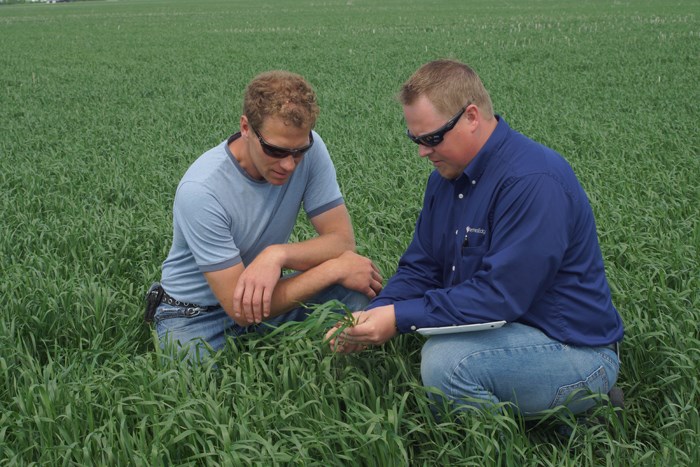In-season crop scouting may not feel as rewarding as planting or harvesting a crop, but it’s just as important. And the earlier you start scouting fields for crop progress, the better.
Crop scouting – getting out there to intently look for emergence, stand, pest, or disease issues that might be robbing yield potential – should start almost as soon as you finish seeding a field.
“Early-season scouting sets you up for success throughout the season,” says Jamie Denbow, product manager for Farmers Edge. “It lets you check the plant population being established in a time frame that still allows you to take remedial actions. Later scouting is important, of course, but it’s too late to fix a planting issue. At that point you are simply scouting to help preserve what got established back in planting season.”
Richard Marsh, also a product manager for Farmers Edge, says scouting should start before the crop has even emerged. “If necessary, you have time for a glyphosate-plus-partner application to control an early season weed flush,” he says. “It usually is more economical to control weeds early, and a clean field helps keep yield potential high.”
Denbow offers a simple four-point checklist to follow as you do early-season scouting.
• Number and spacing of plant population
• Presence of any early season pest pressure
• Any irregular color or growth pattern - it usually indicates a crop stress
• Any difference in crop establishment between field zones or topography.
He recalls scouting a customer’s sunflower field. The farmer was concerned that a soil-applied chemical was thinning the plant stand. “It was occurring in just some areas of the field,” Denbow says.
“When we looked closely, we saw that some plants were snipped off at the soil surface from cutworms. He applied an insecticide that day, the thinned areas filled in nicely over a few weeks, and he ended up with a successful crop.
“If we hadn’t done that early scouting, or if we had waited just a few days, the insects would have had such a head start that the crop might not have been salvageable.”
Another grower had planted a high-value certified seed crop. Early scouting showed that emergence across the field was spotty, and prompted the farmer into a more intense scouting trip.
“That’s when he noted patches of a noxious weed,” says Denbow. “Early in the season this weed was easy to control. If left for just a few more days, it would have been much costlier, maybe involving hand-rogueing.”
Marsh speaks of a grower who ran out of seed in the planter on the last 10 acres of a field, and didn’t realize it. “Those things happen, but fortunately he did an early scout at crop emergence and discovered it. He got right back in there and seeded the missed area.”
There are many innovative tools available that can aid in crop scouting success by pointing you to areas of the field that may need extra attention or to show areas that may have been missed, as with the grower who ran out of seed. For instance, As-Applied Maps will show such things as chemical overlaps or skips. These maps can guide you to those areas of the field for a close-up inspection as you scout. By sourcing and identifying issues before they impact the field, growers are more equipped to make proactive instead of reactive decisions.
At this early point of the growing season, Denbow recommends that you scout every field at least every 10 days. “And if you think there is an issue developing, I’d make that every 5 to 7 days.
Farmers Edge assists their growers with crop scouting. “First of all, we offer a scouting service for those farmers who want to entrust it to our professionals,” says Denbow. “Some farmers like to have an independent and unbiased opinion on their crop input needs, or they don’t have the time for that responsibility.
“We also have a scouting software program, called eScout, that will be released soon for customers. It’s a fantastic way for them to efficiently collect pest and other field information by location.”
The new program will allow you to flag geo-referenced patches within fields and mark the borders on the computer field maps as you are scouting. You can note what you saw – such as a weed patch or a wet spot – and exactly where you saw it for later reference. This information is stored in FarmCommand, the Farmers Edge farm management platform, with all your other information so that an entire field story and history can be built. You can monitor those geo-referenced patches within fields over time.
Marsh emphasizes the long-term value of using all of these tools to build field histories. “With the history in FarmCommand, Farmers Edge will be able to send out alerts if your cropping plan raises a red flag to a potential residual herbicide issue, a volunteer crop issue, or another weed issue,“ he concludes.




